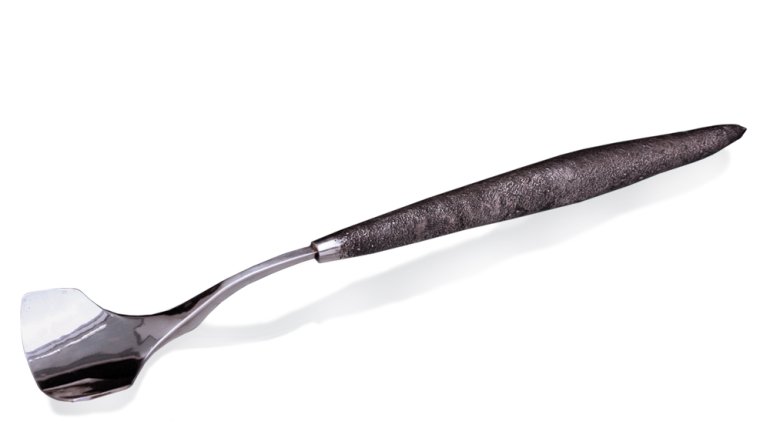Back to the Future
Back to the Future
In August 1994, material history was made, and Maine metalsmith Tim McCreight had a seat at the table. He was among a handful of people who met with representatives from Japan’s Mitsubishi Materials Corporation about a clay-like substance, made of metal powder, water, and binder, which, when fired, became solid fine silver. The executives were eager to introduce it to American jewelry makers.
Today, thousands of artists, many of whom have little or no background in traditional metalsmithing, use metal clay. We asked McCreight, who works with metal clay as well as traditional metals, to tell us about the beginnings of this groundbreaking material.
In 1994, you and master jeweler Ron Pearson met with two Japanese executives about the material that has come to be known as metal clay. Did you imagine at the time the potential of the material?
No. We met with these two guys in Ron Pearson’s kitchen. And they were describing something that looked like clay but was actually silver. I thought, “Is there a language issue here?” Because it sounded like they said it looks like clay and it turns into silver, which is impossible. And so we started with disbelief.
Then they were showing us work. There came a point when the table was pretty much covered with 75 or 100 small pieces of jewelry. And everybody was hunched over the table, and I remember sort of rearing up and straightening up my head at the same moment Ron did. We made eye contact. And what I read in his eyes was “This stuff is pretty ugly. But if what they’re saying is true, this is pretty fascinating.”
They had duplicated what I would call Avon jewelry, just sort of run-of-the-mill, lowbrow, kitschy jewelry. I thought, “If it’s not about the product but about the process, this could be really exciting.”
What happened next?
They gave me some silver clay to experiment with. I made a bunch of little things, little animals, squeezing things with my fingers. I put them in the kiln I had, a regular electric jewelry kiln, and went away for a couple hours and came back. And the whole kiln was just full of little balls of silver, because I had melted it.
I still hadn’t wrapped my head around that it was metal. It wasn’t like a mystery or they hadn’t explained it, but still it didn’t register to me that I had to be worried about it melting.
You were still figuring it out. Now, after that first meeting, you and Ron persuaded the executives – who wanted to know how to appeal to US jewelers – to fund a week of material research at Haystack Mountain School of Crafts with 14 other metalsmiths. The group included luminaries such as Sharon Church, Eleanor Moty, J. Fred Woell, Myra Mimlitsch- Gray, and Jack Prip. What happened there?
It was a dream team, unquestionably. And we worked hard. They sent over two guys from Japan, one from marketing and one from the technical side. The latter was basically the technician who physically made the metal clay, who mixed up the recipe and produced it. So these two guys were there, and we worked them to death. We’d be up first thing in the morning and late at night. I can say proudly, looking back on it, that at least two or three of the fundamental things that are still being done with metal clay were invented or discovered at that one-week session.
What were those things?
Sharon Church was frustrated because the clay was drying fast. So she said, “I’m going to just sort of pre-form something, get a general shape. I’m going to purposely let it dry. And then I’m going to work it with files and sandpaper and chisels.”
It’s hard to imagine how radical that is, because a lot of us work that way with the material now. And Mitsubishi had been working for three or four years to create a material that would stay pliable as long as possible. They never would’ve gotten to the place of saying, “Here’s another way to work it.” That was pretty huge.
Chris Ramsay came up with the idea of mixing glass powder – enamel – into the clay and created a hybrid material that was neither metal nor clay. And Jack Prip did something similar with earthen clay. He mixed up clay in silver and, again, created a hybrid material.
Twenty years later, what has surprised you about metal clay?
Originally, I would have thought that traditional jewelers would have embraced it more. It turns out that to convince working metalsmiths that metal clay is not a product of the devil and not a convenience product and has something to offer to them has been a heavier lift than we expected.
What are the advantages of metal clay?
They are: a quick learning curve, low initial investment in tools, quick turnaround, and – and this is the most important one – there are some looks that can be achieved with metal clay that are difficult or impossible with traditional means.
What are the disadvantages? What can’t it do?
It doesn’t lend itself to very fine work. I don’t think you could do filigree or very, very fine, very thin sheet work. There’s a limit.
What do you see as the future for the material?
There is a generation coming up for whom metal clay will take its place as just another way to make jewelry. You can forge. You can cast. You can do repoussé. You can do metal clay. It’ll be one of those things. We’re going to see more of it on Etsy. We’re going to see more of it in the magazines. We’re going to see more of it in the high-end galleries. So is it taking a while? Yes. Is that to be expected? Absolutely.
Monica Moses is American Craft’s editor in chief.




